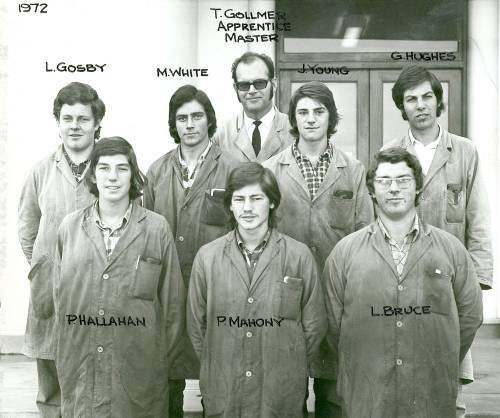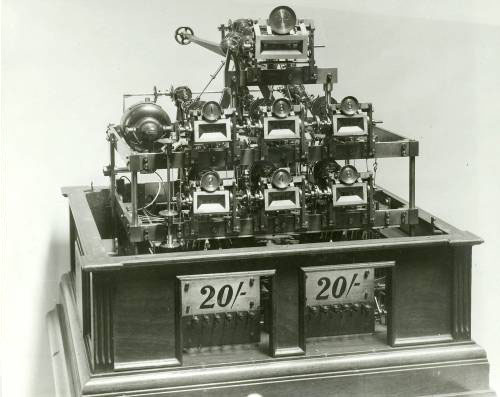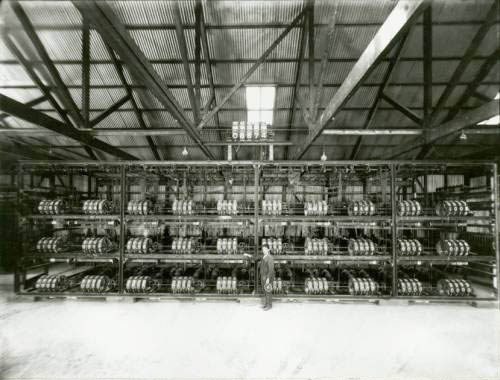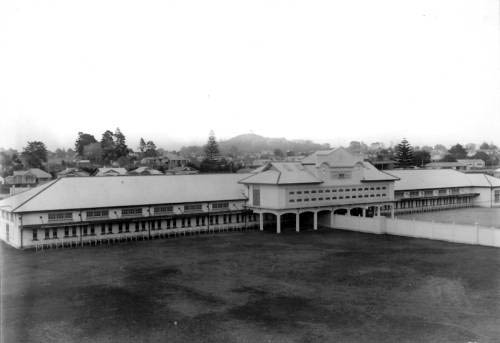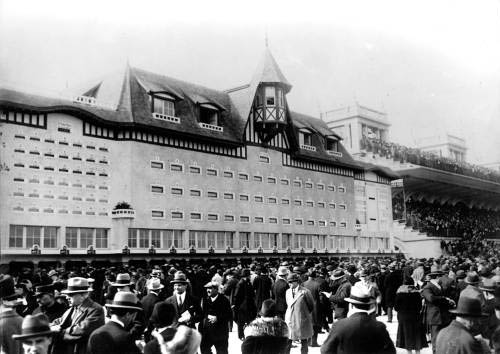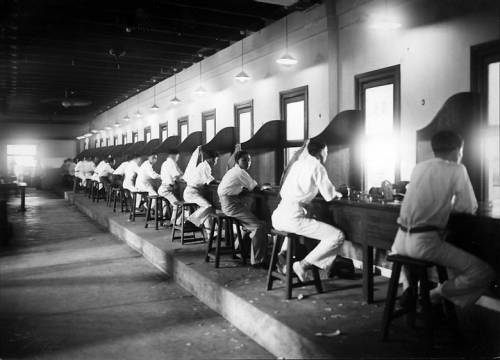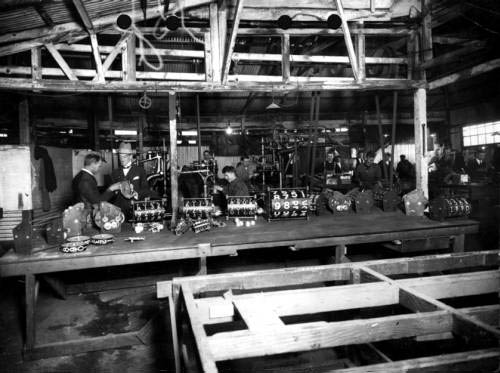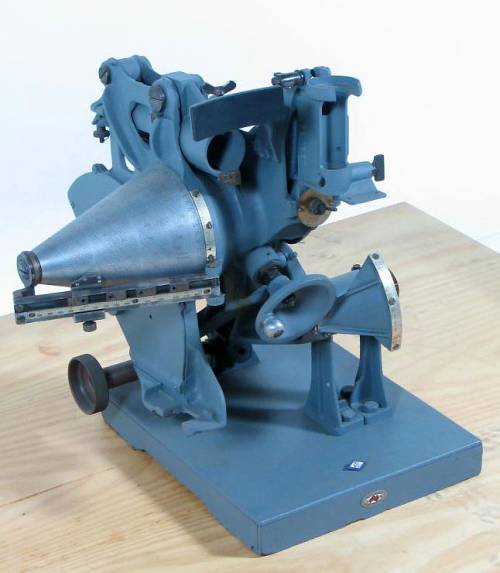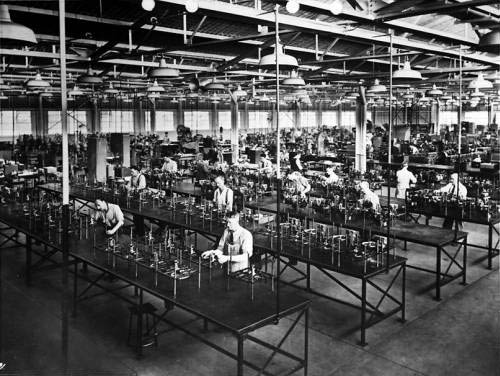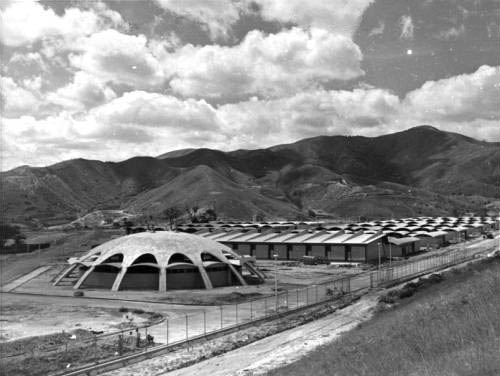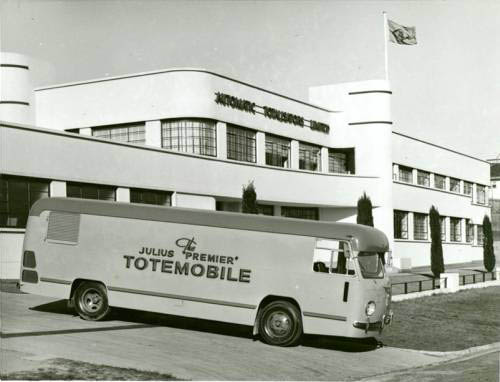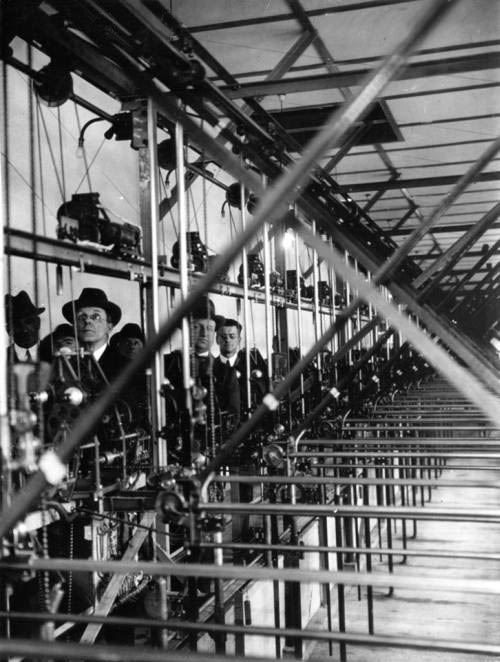An Unlikely History of Australian Computing: the Reign of the Totalisator
Lindsay Barrett and Matthew Connell
A Dusty Legacy
In 1994 the Powerhouse Museum in Sydney received a telephone call from the electronics company Amalgamated Wireless Australia (AWA), requesting that someone from the Museum be sent to inspect a collection of old totalisator equipment at one of the Company’s premises. AWA was Australia’s oldest and most high profile electronics manufacturer, and had come into possession of the Tote equipment through its acquisition of a company called Automatic Totalisators Limited (ATL), in the 1980s. This equipment, once used to mechanically calculate the betting odds at Australian racecourses, had long been redundant, and AWA was unsure what to do with it: should it just become landfill, or was it worth preserving?
So the Powerhouse’s Curator of Engineering and Design and the Curator of Computing and Mathematics soon found themselves at a small factory in the Sydney suburb of Homebush. Past a production line making traffic light controllers, they were led to a small demountable office that had been erected inside the larger factory building. They were then instructed to climb, via a ladder, onto the office’s roof. Here was scattered an untidy collection of ticket dispensing machines, deconstructed mechanical and electronic components, slide rules, odds indicators, boxes full of papers and lists of figures, and a filing cabinet, all of it covered in a thick layer of dust. On inspection, the record boxes and filing cabinet revealed a large collection of glossy black and white photographs, company brochures, newspaper clippings and company records, what remained in fact of the entire company archives of Automatic Totalisators Limited. There had at one time been a great deal more, but much had been lost due to water damage.
Spread of the Australian ‘Tote’
ATL had in fact been one of Australia’s most successful companies in the first half of the twentieth century, dominating the international Totalisator industry for sixty-five years. But ATL’s market dominance had declined during the 1970s and, after changing hands a few times, the company’s racetrack operations finally ended up in the possession of the New South Wales Government’s betting corporation, TAB Corp. During its sixty-five year history ATL’s records staff had shown had an obsessive commitment to documenting, in both written and photographic form, their company’s efforts. All of the company sites, component production plants, individual products, constructions, operations and staff had been meticulously depicted and recorded. But, following its demise as an independent company in the early 1980s, ATL’s subsequent owners had, just like a careless and carefree punter with his winnings, frittered away this legacy.
By 1970 most major racetracks in the world were using a Totalisator manufactured by ATL. Within two decades, all of these devices had become redundant. The spread and uptake of computerisation had made ATL’s machines superfluous and allowed other companies to enter the totalisator market. And here we find an example of an irony that is repeated again and again in the history of technology, because it was the Australian totalisator’s very successes which helped to spur on the creation of a new generation of machines that would actually supersede it, and turn it into a pile of junk lying around at the back of a factory in the western suburbs of Sydney. History, as we know, is written by the winners, and in the history of computing, which has largely been written in Britain and the United States, it is the military and their patrons in government who are generally credited with having driven the development of computing during the twentieth century. But a history of Australian computing may look a little different to this, because it would be a history motivated, as unlikely as it may seem, not by the desires of the organs of killing and conquest, but by punters, gamblers and bookmakers.
Still, the development of the totalisator machine also sits comfortably within a wider technological narrative of the past two centuries, that of efforts to mechanise the previously human, thought-based task of calculation. As with all transformative technological innovations, its creation was a development that drew together a number of parallel though hitherto unconnected socio-technological forces. A useful starting point for this story might be sometime in the 1860s, when a Monsieur Oller in Paris created a form of betting which was specifically designed to exclude bookmakers. The Pari-mutuel system involved pooling of all bets on a particular race and, with a fixed percentage removed for the Tote owner, the poll was then divided amongst those who held tickets for the winning horses.
The Pari-mutuel system was eagerly adopted by many Australian and New Zealand punters who liked the idea of the ‘natural odds’ offered by the ‘Tote’, rather than the ‘artificial’ odds of the bookmaker. However, while the process was simple in its conception, it was very difficult to administer. As betting proceeded, a tally had to be kept of the number of bets on each runner, and of the grand total. Like most large-scale hand calculation tasks, an army of clerks was required to register and count the bets and, naturally, human error-generated problems abounded. None of this was very well tolerated, because nothing upsets a punter like not being able to bet their winnings on the next race.
Shortly after the spread of this system there were a number of attempts to create machines to facilitate the process, particularly in Australia and New Zealand. These mechanical systems varied in complexity from tins into which marbles were systematically dropped, to systems with elaborate mechanical linkages that displayed a running total of bets. All such semi-automated systems suffered from varying degrees of unreliability, and Tote betting itself was often seen as being as much a contributor to, as a solution for, the problems of the efficient management of gambling.
From Vote-counter to Tote
The patent records for the early years of the twentieth century in Australia show several entries for both Totalisator machine designs and vote counting machines. At this point a young engineer named George Julius enters the story. Julius was born in England in 1873, and migrated not long afterwards with his family to Ballarat in Victoria, where his father had been appointed Anglican Archdeacon. In 1885 the family moved on to New Zealand, as Archdeacon Julius had now become Bishop of Christchurch. George Julius then studied railway engineering at the Canterbury College of the University of New Zealand, and, after graduating, moved in 1896 across to Western Australia to take up a position as an engineer in the locomotive department of the Western Australian Government Railways.
These were the days when the mechanical engineer was regarded as one of the great heroes of modernity. The widespread combination of the railway and the telegraph during the 1840s had generated a massive industrial revolution, the effects of which were still being felt (and perhaps are still being felt even now!), and in industrial societies mechanised solutions to population-based problems of transport, communication and information management were being sought by engineers on a daily basis. Therefore, despite the fact that he was a railway engineer, in his spare time George Julius began work on designing an automatic vote counting machine for use in elections. Such productions were of course a global phenomenon, and we can see Julius’ efforts in the geographically isolated city of Perth as part of a much larger techno-cultural movement, of which the most successful outcome was Hermann Hollerith’s creation of his census data processing machine in the United States in the 1890s.
Neither the West Australian Government nor Australia’s Federal Government showed interest in Julius’ vote counter though, and in 1907 he moved over to Sydney with the project still on his drawing board. As the story goes, a friend recommended to Julius that he accompany him to the racetrack so that he might observe an alternative application for his device. With his religious background, Julius had apparently never seen a racetrack before, but was instantly captivated by the possibilities for mechanical calculation which the scenario provided. As he put it:
I found the problem of great interest as the perfect Tote must have a mechanism capable of adding the records from a number of operators all of whom might issue a ticket on the same horse at the same instant … I set to work on a machine that would permit the simultaneous addition, give instantaneous records, and would satisfy the requirements of any racecourse.1
For the next four years, between 1908 and 1912, George Julius worked on a model of a mechanised totalisator machine in his garage behind his house in Woollahra in the eastern suburbs of Sydney (Figure 1). ATL donated the model to the Museum of Applied Arts and Sciences (now the Powerhouse Museum) in the 1950s, and while it was always regarded as an example of extraordinary mechanical engineering, during the 1990s, as awareness of the history of information processing grew, it was further recognised as a computing device, perhaps even an Australian proto-computer.
From Mechanical to Electrical Tote
Meanwhile, AWA was persuaded to release the ATL archive to the Powerhouse in 1994. The earliest material in the archive is a series of glass plate negatives of what appears to be the first full size Tote machine built by Julius, which was commissioned by the Auckland Jockey Club and installed at Ellerslie racecourse in 1913 (Figures 2 &3). It was a completely mechanical machine, and power was supplied by cast iron weights pulling bicycle chain over drive sprockets. Following their creator’s own trail around southern Australasia, the second machine was then installed at Gloucester Park Racetrack in Western Australia in 1916. In 1917 Julius formed ATL, electric power was introduced as the machine’s drive source, and by 1930 there were thirty-six ATL Tote machines installed around the world. The largest installation was at Longchamp in Paris (Figure 4). It could handle up to 42 runners in a single event, incorporated 300 ticket-issuing machines, and performed extraordinary feats of simultaneous calculation for the time.
The ATL Totalisator had four essential components: the ticket machine, the adder, the odds calculator and the indicator. The ticket machines were placed at the windows of the Tote house and other sundry buildings at the racecourse. When punters placed a bet at any ticket machine it provided a ticket (this being a secure receipt for the bet) while simultaneously registering the bet on the adder, thereby incrementing the total for the particular horse, as well as the grand total for the race. The odds calculators determined the ratio of the bets on each horse to the grand total (the likely dividend), and that information was transmitted to the odds indicator, usually mounted on the front of the Tote house.
The odds calculator was a later invention than the other three, but all components, indeed all aspects of the Tote mechanism, were subject to ongoing refinement. The rarely glimpsed calculating mechanism of the machine consisted of vertically delineated banks of adders, each with a dedicated odds calculator and odds transfer box, with all adders connected to the drive shaft. Usually there were two such banks back to back. These were in effect two separate Totes: a win Tote and a place Tote. At the end of the row was the grand total adder and the grand total gearbox which incorporated a mechanism for subtracting the owner’s and the government’s fractions of the pool before the odds were calculated and displayed.
The ability of every ticket machine to address every adder was made possible by a system of rotary switches similar to a distributor in an internal combustion engine. They were multiplex switches that would check for incoming data from a number of channels on behalf of the adder. The actual computation done by the Tote was relatively trivial. It was in fact a simple aggregation and division, but what made it sophisticated was the fact that it was a very early (in computing terms) real-time, multi-user system incorporating an extraordinary level of security and data integrity. Engineers who worked on the design of the last purely electro-mechanical ATL Totes maintain that, within their context, the machines were perfect.2
By the late 1920s ATL was selling its products to racetracks around the world. Figure 6 shows the manufacturing plant in Newtown in Sydney: a somewhat disorganised, dirty workshop, the desks strewn with tools and rags and part of the floor still made of packed earth. But in 1930, the ATL workshops moved from Newtown to the southern end of Sydney’s CBD, and established one of the best precision machine workshops in Australia. With the start of the Second World War though, the ATL workshops were conscripted to national service and ordered to produce gun sights and other munitions (Figure 7). At this point ATL’s history briefly linked up with the more famous and generalised history of computing—naval and artillery gunfire trajectory calculation being a key driving factor in the development of American computing—though in Australia this arrangement was not to outlast the war. As soon as Japan surrendered in 1945, demand for Tote equipment again soared, along with ATL’s fortunes, and the company moved once more to new facilities, on the Parramatta River at Meadowbank.
The contrast of the Meadowbank factory (Figure 8) with the original Newtown facility is striking. The postwar premises invoke the cleanliness of a scientific laboratory rather than the grime and chaos of a nineteenth century machine shop, as this particular aspect of the management of precision manufacturing in Australia adopts the modernist ethic of the technological sublime.3 The ATL-manufactured Tote built at Caracas in Venezuela in 1957 provides a similar example (Figure 9). The Caracas device was one of 99 new totalisators that ATL installed around the world in the years after the Second World War. Dating from the same period in which Brazil’s radical modernist architect, Oscar Niemeyer, was building the futuristic capital city of Brasilia, the exterior construction of the Caracas Tote celebrates the dreams of a neat, clean and orderly future which the modernist creed of mechanisation offered in those years.
Another key promise of technological modernity was Mobility. Not only, it seemed, could machines liberate us from the drudgery of boring tasks like calculation, they could also free us from the tyranny of distance. In this sense the mobile Totes, which ATL first began producing the 1940s, were exceptionally sublime machines, bringing together mechanised calculation with the twentieth century’s other great transformative technological form, motor-driven mobility. Built to operate at rural and suburban racetracks around Australia, the truck-based Totes often ended up being used as extra Totes on Metropolitan tracks too, as well as being exported to New Zealand (Figure 10). They came in various shapes and sizes, but were specifically designed as a self-contained unit. They were a great success, though some of the ex-ATL employees who staffed them say that their cramped and often very hot interiors were generally a nightmare to work in.
Rise of the ‘Universal’ Computer
Yet, as we outlined earlier, despite their almost global monopoly on the provision of totalisators, and their status as purveyors of cutting-edge calculation technology, the spread of digital computing during the 1970s made ATL’s products suddenly redundant. Here the word redundant is the key to understanding this process. The general purpose computer, we can say, is a machine bursting with redundant possibility, in that it is, by way of Alan Turing’s famous definition, a universal machine. It can, by the very nature of its architecture, be applied to a possibly limitless series of tasks. The ATL Totalisator on the other hand was a fully dedicated machine designed for a single task. It possessed virtually no redundant possibility, a fact that in turn made it particularly vulnerable to the processes of redundancy inherent within the paradigm of technological evolution.
Again, irony was at work here. By late 1956, an ATL Totalisator provided the capacity for simultaneous data processing, and despite the fact that the machines possessed no memory function as such, they were still capable of holding information in train so that system shutdowns did not automatically loose current transactions. At this very same point in time, the first computers to operate in Australia, SILLIAC at Sydney University’s Physics Department, and CSIRAC, operated by the Commonwealth Scientific and Industrial Research Organisation (CSIRO) at the University of Melbourne, were mere single-user machines. But this of course was an instance of technological dominance that, like most, was only fleeting.
The ATL Totalisator is worthy of its leading place in the history of Australian computing because its effect on the subsequent development of mechanised calculation and data management in Australia has been, to turn the metaphor of the machine back on itself, incalculable. In the history of technology it is the oblique, everyday connections that matter as much as the great and the grand ones. Indeed, in this story, an excellent example of one such link is provided by the one-time Sydney schoolboy David Myers. Myers would eventually become one of the CSIRO’s chief computer scientists and he was instrumental in, amongst other things, the development of CSIRAC. It was a glorious career, and in fact it was a career that Myers had been set upon ever since the day George Julius had visited his high school and given a lecture on the Totalisator and mechanical calculation, an inspirational talk within which the young schoolboy had found a lifetime of encouragement.4
Much later, at the Physics Department at Sydney University in the early 1950s, Harry Messel and John Blatt were casting around for a benefactor to underwrite the building of that institution’s first computer. They found one in the form of the optician, jeweler and punter Sir Adolph Basser. With the prize money won by his horse Delta at the 1951 Melbourne Cup, Basser had set up a research trust fund. Messel and Blatt asked him to donate £50,000 from this fund to the SILLIAC project, and the rest, as the cliché has it, was history5. Meanwhile, thousands of punters across the country picked up their winnings courtesy of the Totalisator, while others just tore up their machine printed ticket stubs and scattered them to the winds. It was just another day in the unlikely history of Australian computing.
Notes
1 Max Anderson and Pierre Cochrane, Julius, Poole and Gibson—The First Eighty Years—From Tote to CAD. Sydney: Julius, Poole and Gibson, 1989. pp. 5-6.
2 Interview with Neville Mitchell, former ATL engineer, by Matthew Connell, Powerhouse Museum, Sydney, 2003.
3 For a definition of the ‘technological sublime’, see David E. Nye, American Technological Sublime, Cambridge, MA: MIT Press, 1996.
4 Interview with David Myer, by Doug McGann, University of Melbourne, 1996.
5 John Deane, SILLIAC: Vacuum Tube Supercomputer. Sydney: Science Foundation for Physics, 2006. p. 30.
For an extensive collection of Totalisator resources see Totalisator History—An Australian Achievement, a website created and maintained by Brian Conlan, at: http://members.ozemail.com.au/~bconlon/index.html#index

